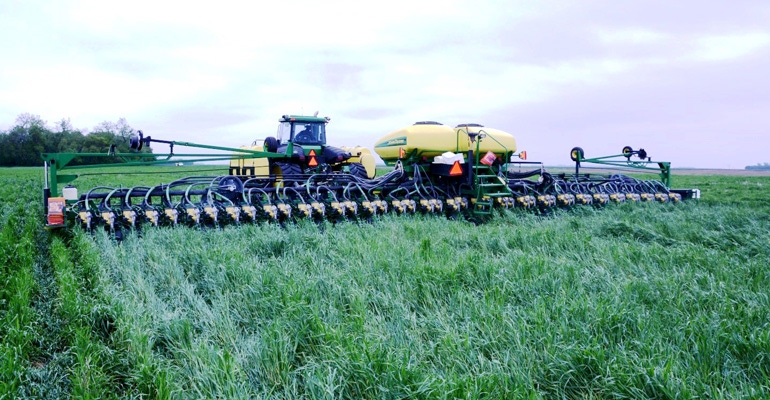April 1, 2020

After enduring soggy soils repeatedly during 2019, South Dakota growers can’t wait to see crops emerge from last year’s Prevented Plant fields.
From field condition and weed control planning to fallow syndrome, fertility, green planting and interseeding cover crops — check out current advice compiled by agronomists and soil scientists from USDA Natural Resources Conservation Service (NRCS) and South Dakota State University Extension, with involvement from South Dakota's Conservation Districts, South Dakota Soil Health Coalition, South Dakota Grassland Coalition and South Dakota Corn Growers.
Examine field ruts, erosion issues
Survey your fields to determine if ruts and gullies are severe enough to affect planting. Wait until the top 2 to 4 inches of soil dries and then make several shallow tilled passes using very light tillage only in the rutted area. No-till fields with functional soil biology will heal shallow ruts without need for tillage. “Farmers would be surprised at how much a crop can reduce the ruts,” says Sara Bauder, SDSU Extension agronomy field specialist. “Cover crops can help really break up those ruts and level things off in a year or two.”
Visit SDSU Extension online for more details.
Plan for added weed problems
If Prevented Plant fields had patches of possible herbicide-resistant weeds (such as waterhemp, marestail, kochia, and other annuals) that went to seed, agronomists recommend a soil-applied pre-plant or preemergence residual herbicides to target your weed species. Properly managed no-till fields, where weed seeds stay on the surface, increase the effectiveness of soil-applied herbicides.
“It can be an effective option to consider planting [Prevented Plant] fields last that had high weed density in 2019,” according to Gared Shaffer, SDSU Extension weeds field specialist. “This will give more opportunity to control early emerging weeds with burn-down and preemergent herbicides. Making sure of proper control of these early weeds before planting is extremely critical. Use a multistep approach to weed control through the use of preemergent herbicides with overlapping residuals, with a tank mix of herbicides with multiple sites of action. If possible, use an herbicide with separate sites of action for the post-emergent application.”
If planning to seed cover crops in-season or after harvest, be sure to check herbicide half-life in the soil. If you applied herbicides last summer, also check for possible herbicide carryover.
Make sure to always read your herbicide labels, check out the Nutrient and Pest Management Program’s resource on herbicide rotational restrictions.
Be aware of potential fallow syndrome on corn
If no cover crops were seeded on your conventional-tilled or minimum-till Prevented Plant field (or only brassica cover crops like radish, turnip, mustard or rapeseed), the soil might lack key beneficial organisms, e.g., mycorrhizae fungi, that support early corn growth.
Some agronomists and long-term no-till farmers believe that no-till fields are probably less susceptible to fallow syndrome due to better soil health.
“We know that mycorrhizal fungi are greatly reduced in tilled systems, and I think our soil health systems [no-till, strip-till] are going to show more resilience,” says Anthony Bly, SDSU Extension soils field specialist agronomist.
To overcome this potential soil biology challenge, some agronomists recommend the addition of phosphorus (P) and chelated zinc in-furrow as a pop-up starter or a banded application to minimize early-season growth challenges and potential yield loss from fallow syndrome. If that’s not an option, broadcast application rates that include an additional 15-20 pounds P per acre will also help, according to Antonio Mallarino, Iowa State University Extension.
Soil test to learn fertility levels
Any nitrogen or sulfur applied in the spring of 2019 is gone unless a cover crop was seeded before summer. Collect new soil tests to determine your ever-changing nutrient availability. Don’t rely on 2018 or 2019 tests. Watch saturated soil test results for accuracy. Mobile nutrients, like nitrogen and sulfur, require a deeper soil test — down to 24 inches. Phosphorus, potassium and zinc only need a 0-to-6-inch-deep soil test.
No-till plant into a green cover crop
Some growers believe the seedbed is better when planting into a living cover crop due to less compaction in the seed slot, plus the cover crop continues to take up water to dry soil conditions for planting. Growers who plant green (soybeans are easier and more forgiving than corn) enjoy the benefits of better erosion control, higher surface organic matter, reduced soil moisture at planting and more.
Your termination time will differ depending on which crop you’ve planted. For soybeans, terminate the cover crop either at planting. For corn, terminate two weeks before planting. Make sure to check current RMA insurance cover crop termination rules for your area.
Also make sure to adjust your planter. Check that the planter is running level, that row cleaners have broad, shorter teeth and are adjusted to barely touch the soil, and that opener blades are sharp and seed tube guards are new; adjust downforce pressure for consistent depth; make sure seed depth in various field conditions; use seed firmers; and select proper closing wheels for your soil and residue conditions.
Learn more by visiting the Iowa Soybean Association online.
Lawton writes from Eden Prairie, Minn.
Source: NRCS, which is solely responsible for the information provided and is wholly owned by the source. Informa Business Media and all its and all its subsidiaries are not responsible for any of the content contained in this information asset.
About the Author(s)
You May Also Like






